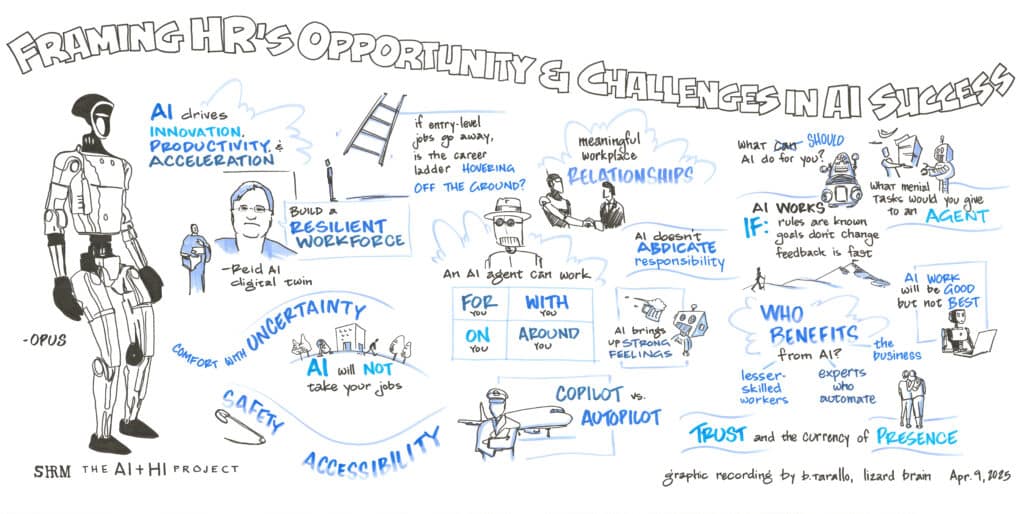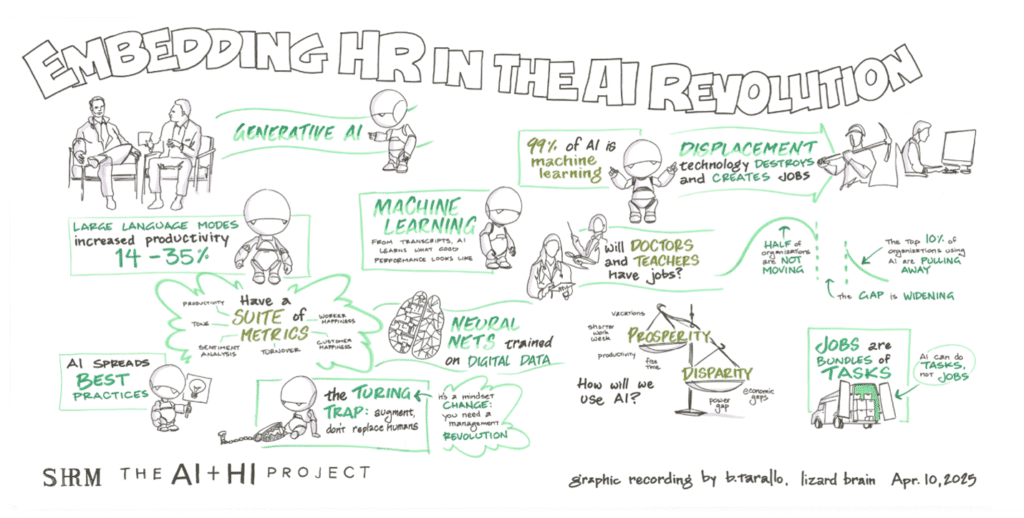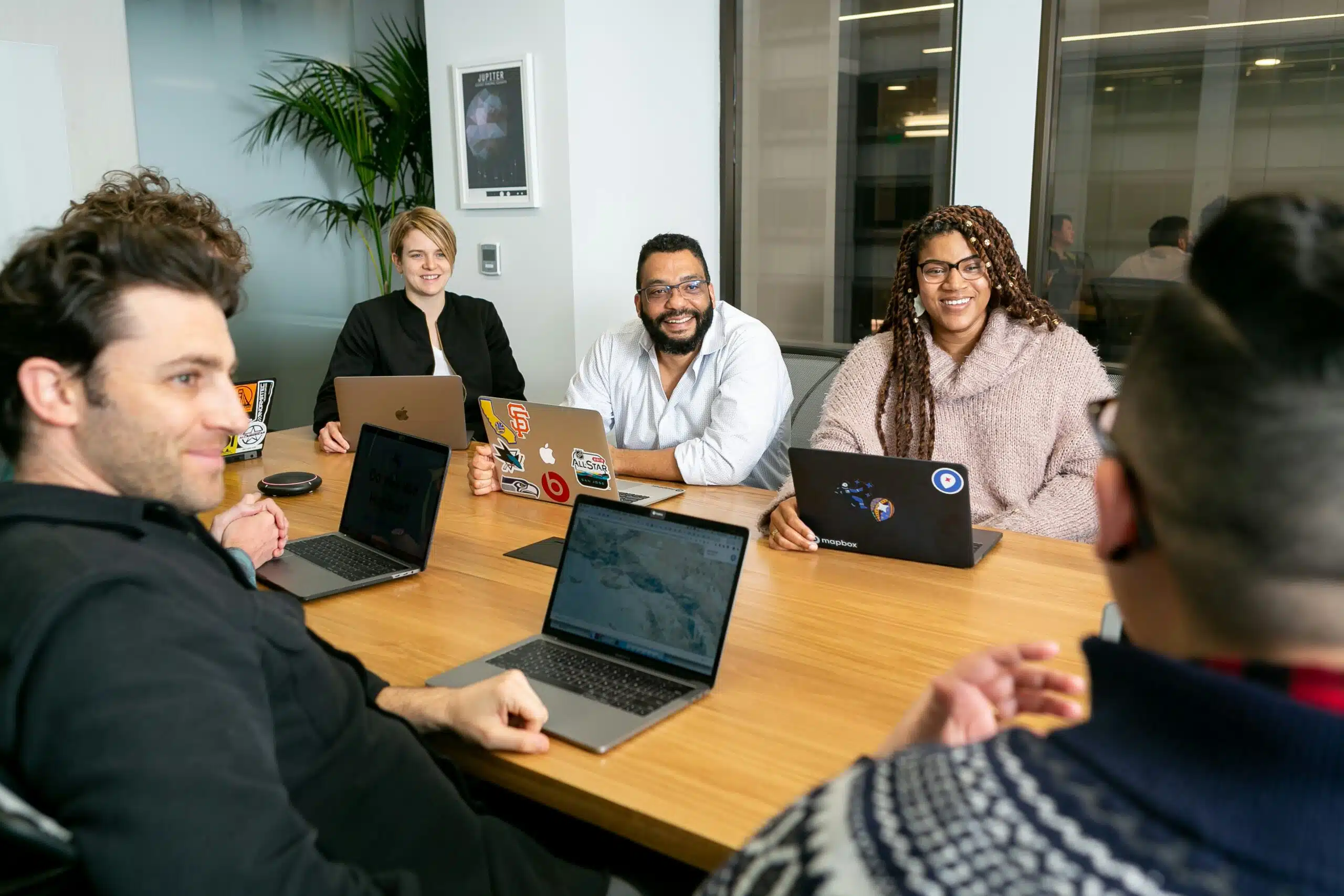
Facing Fear, Building the Future: AI and HR’s New Role
Brian Tarallo on why HR must guide AI adoption — and how to dismantle fear through experimentation.
As AI reshapes the workplace, HR finds itself at the center of a cultural transformation. We sat down with Brian Tarallo — graphic recorder, facilitator, and organizational development expert — to talk about fear, experimentation, and why HR is uniquely positioned to lead AI at work.
HRInsidr: What was your role at the 2025 SHRM AI + HI event?
Brian Tarallo: My role at this particular conference was as a graphic recorder, meaning I was taking visual notes of what I heard from the speakers, panels, and presentations.
HRInsidr: Beyond graphic recording, you also facilitate for a lot of these groups in the audience and understand the pain points these organizations are going through, right?
Brian Tarallo: Yeah, the kind of work that we do at Lizard Brain, ranges from visual note-taking to designing and facilitating primarily participatory decision-making processes. Which means groups come together to make decisions about things like strategic plans, values, visions, or missions.
What makes Lizard Brain a little different from other facilitators or graphic facilitators is that we have a background in management consulting and organizational development. We lead with the human side of what’s happening inside an organization.
The SHRM conference was very aligned with our work. We focus on the human dynamic, the cultural side.
HRInsidr: With that experience, can you tell us more about the tone of the audience in the room?
Brian Tarallo: There were a lot of mixed feelings, but the dividing line was fear. Some people were afraid of AI—afraid it would take their jobs or make them irrelevant, especially in transactional HR tasks like benefits administration or answering routine questions. Tasks that, honestly, chatbots have already been doing for a while.
Then there were others who weren’t afraid at all. They were encouraging people, saying, “Just try it. Once you use it, you’ll understand what it can do—and what it can’t.”
This moment with AI is like the early days of the internet. Back then, people were scared too, wondering, “What’s this going to do?” Some bad investments happened during the dot-com boom, but ultimately the internet became essential. It’s the same now. People are struggling to figure out where AI fits as a tool.
The people who are most afraid of AI are often the ones who haven’t used it. And it’s not that AI is going to replace people—it’s that people using AI are going to replace people who don’t.
HRInsidr: That’s a striking point.
Brian Tarallo: One person who stood up—and asked to stay anonymous—said, “I’ve trained a version of Chat GPT to do 100% of my job, and I haven’t told my boss yet.” That got a big laugh.
The speaker responded, saying it’s a shame you can’t tell your boss because if you could, you’d be freed up to do more creative, unique work—the kind AI can’t touch. From what I heard, people seemed afraid — not because they knew what AI could do, but because they hadn’t used it yet. There’s so much ambiguity. Some didn’t even know if they should be using it, or if they needed their boss’s permission.
HRInsidr: Last year at SHRM, the event was called What is AI. This year, they were trying to go deeper, but honestly, I feel like a lot of people are still wondering what it is.
Brian Tarallo: One of the best comments I heard was that at some point, we have to stop talking about AI and start using it. If I was facilitating this conference — I would’ve said, “Alright, everybody take out your phones, open ChatGPT, and let’s play around.” Because most people’s experience with AI stops after asking it one question. They treat it like Google: you type a query, you get a result, and you’re done. They don’t realize AI is a dialogue — it’s intended for you to go back and forth with it.
HRInsidr: That would really dismantle some of the fear. Just by putting it in people’s hands.
Brian Tarallo: Absolutely. In fact, AI should be thought of as your own private consultant. It’s your assistant, your subject-matter expert. One competency we all need to build for AI is asking better questions. AI is literal — it gives you what you ask for. If we learn to ask smarter questions, we’ll get smarter results.
HRInsidr: I feel like that’s what we were told with Google, ask better questions, get better keywords, but this is different it’s about asking deeper questions, right?
Brian Tarallo: Exactly. It’s a mindset shift. Instead of seeing AI as a black box, it’s about seeing it as something you can collaborate with — shaping the output, refining it, conversing with it.
There’s definitely going to be an adoption curve. Some people will be on the bleeding edge, jumping in. Others will resist it.
And here’s the thing: even in places banning AI, “shadow AI” is happening. Employees are using it anyway — on their phones, at home, quietly at their desks.
I have a client who said, “We’re not using AI at all — our data’s too sensitive.” But at the same time, people inside that organization are absolutely using AI tools. You can’t just put your head in the sand.
HRInsidr: Right, it’s like trying to ban the internet.
Brian Tarallo: Exactly. You’re asking people to work with one hand tied behind their back. In today’s environment, that’s just not sustainable. The better approach is to ask: “How might we use it safely?” rather than banning it outright.
HRInsidr: I think that idea of making it safe is really important — to help people just play with AI without the fear of exposing confidential information.
Brian Tarallo: Right. We need to build a sandbox. Give people a safe space to experiment, without the pressure of feeling like they have to get it right the first time. When you’re learning anything new — like driving a car — it’s mechanical and awkward at first. Same thing here. HR could really support that by encouraging people to mess around with AI, break it, push it, see what it can do.
HRInsidr: Helping to dismantle the fear around it by just trying it out, then you start to imagine what’s possible.
Brian Tarallo: Exactly. And once you start using it, you realize how much potential there is to redesign parts of your work.
HRInsidr: In HR especially, every organization’s culture and employee lifecycle is different. So it’s not about one-size-fits-all AI tools — it’s about reimagining what AI could do inside your specific context.
Brian Tarallo: Exactly. You have to treat AI more like an assistant you’re training. When I use it, I don’t just accept the first output. I’ll say, “Why did you give me this answer? Reference these documents to understand our tone and context. You shape it, teach it, collaborate with it — like you would with a junior teammate.
HRInsidr: It’s fascinating — that whole mental shift from search engine to collaborator.
Brian Tarallo: And it’s going to change what skills we value. People who can ask thoughtful, strategic questions are going to thrive. It’s going to force better communication, deeper thinking. And honestly, that’s something we’ve needed for a long time anyway.
HRInsidr: It feels like it even goes beyond asking questions. It’s a whole new kind of working relationship.
Brian Tarallo: Definitely. And there’s going to be this wide adoption curve. You’ll have the early adopters embracing it, and then you’ll have the laggards — people who resist until they’re forced to change.
And meanwhile, shadow AI will grow. People are already finding workarounds.
The organizations that don’t acknowledge it — that try to ban it completely — are going to fall behind fast.
HRInsidr: Totally. You can’t afford to be left behind right now.
Brian Tarallo: No way. And honestly, the organizations that figure out how to engage with AI — that use it to make work more meaningful — will have a big advantage.
It’s not about building basic AI chatbots to send you information. It’s about asking employees, “What’s the most annoying part of your job? What wastes your time?” And then figuring out if an AI agent could take over those parts, so people can focus on the work they actually enjoy and are best at.
HRInsidr: That’s a whole new way to think about engagement — freeing people up to do better, more meaningful work.
Brian Tarallo: Exactly. Like for me, I spend a lot of time sending the same participant communications before events — logistics, agendas, reminders. Now I’m training an AI agent on my writing style and my event materials. It can draft those emails for me in my voice, cutting a 45-minute task down to about 45 seconds. That’s how AI boosts engagement — by letting me spend more time doing the work that matters.
HRInsidr: You touched on something really interesting — employees may be nervous to admit what parts of their job they don’t love. If your manager is sitting across from you asking, “What’s the worst part of your job?” you’re probably going to sugarcoat it. But with an AI agent, you might be a lot more honest. That honesty could lead to real improvements.
Brian Tarallo: There’s still a lot of fear though, especially around privacy and security. Is it really confidential? People are afraid of feeding sensitive information into open AI systems. And rightly so — a lot of third-party tools aren’t designed to handle confidential data at scale yet. But that’s changing fast. And the risk of not using AI — falling behind, being less productive — is becoming bigger than the risk of cautiously adopting it.
HRInsidr: Exactly. It’s crazy to think how fast this is moving. When you were at SHRM, what were some primary themes you heard?
Brian Tarallo: One big use case was creating FAQ repositories — using AI to scan common emails or requests and automate routine answers.
Another was about culture: recognizing that AI is going to change not just what we do, but how we work. And the consensus was that HR should lead AI adoption — not IT.
If IT owns it, you get a rollout. If HR owns it, you get a transformation. It’s about rethinking work with humans in mind — being deliberate about culture, skills, and experience, not just efficiency.
HR needs to think creatively: “What could AI do for our people?” It’s about imagining possibilities — not just following recipes.
HRInsidr: It sounds like just using AI personally — even casually — can spark ideas for how it could help at work.
Brian Tarallo: Absolutely. You don’t even have to use it formally for big tasks. Just get in the habit of experimenting — asking it questions, seeing what it can do. That’s how you start to build intuition for how AI could fit into your role, your team, your processes. The people who wait until it’s all figured out are going to be too late.
HRInsidr: Was there one session that really stood out to you personally?
Brian Tarallo: Yeah, there was a panel called “From Help Desk to Hero.” The theme was: how do we move HR professionals from being seen as just support — answering benefits questions, fixing problems — to being true strategic partners inside organizations? The idea is, if AI takes over the transactional tasks, then HR can focus on what they’re really capable of: innovation, human-centered design, driving culture change.
HRInsidr: That feels like such an important shift.
Brian Tarallo: It is. They talked about pulling in approaches like design thinking — human-centered methods — and building a culture of agility, flexibility, and innovation. Organizations that stay rigid, stuck in old operating procedures, are going to get left behind.
The ones that adapt — that stay flexible and experimental — are the ones that will thrive.
HRInsidr: And that changes how we think about change management too.
Brian Tarallo: Exactly. This isn’t about locking in a future vision. It’s about building the capacity to adapt — quickly, continually.
One speaker put it well: AI is about enhancement and augmentation, not replacement. You’re not promising people, “Here’s exactly what’s going to happen.” You’re promising, “We’re going to navigate change together.”
HRInsidr: That’s a huge mindset shift for leadership too.
Brian Tarallo: Absolutely. Leaders are going to have to get a lot more comfortable with ambiguity — and with empowering their teams to experiment and iterate.
HRInsidr: Do you think people left the conference feeling more empowered personally?
Brian Tarallo: I did. I think the people who were already experimenting with AI — the early adopters — left feeling energized. The late adopters, the laggards, probably left feeling more scared. But for most people, I think there was a shift toward more clarity, less fear — and most importantly, a willingness to try it out.
HRInsidr: That’s encouraging.
Brian Tarallo: It is. Actually, right after the conference, I decided to push myself to use AI more intentionally. I asked ChatGPT to help me design a web crawler to find RFPs for facilitation work. Within minutes, it had mapped out the tech stack I’d need, offered options, and helped coach me through building something I would’ve never figured out on my own. That’s the power of just trying — you start to see real value quickly.
HRInsidr: I love that. And it’s amazing how AI can be trained to match your style too — whether it’s writing, drawing, or communicating.
Brian Tarallo: Absolutely. When you train it on your voice, your way of thinking, it becomes a true collaborator. It’s still very obvious when something is just AI-generated versus when it’s been human-guided. The best use of AI is as a collaborator, not a replacement.
The people resisting it — they’re the ones who are going to struggle. The ones embracing it are going to be way more productive, way more effective.
HRInsidr: It’s definitely becoming a competitive advantage.
Brian Tarallo: No doubt. Pretty soon, “Do you know how to use AI?” will be as basic as “Do you know how to use email?”
HRInsidr: Thank you so much for this conversation, Brian.
Brian Tarallo: Same here. Thanks for having me.
—
The information contained in this site is provided for informational purposes only, and should not be construed as legal advice on any subject matter.

Advice in Your Inbox
Join our newsletter for free bi-monthly toolkits and downloads on how to hire, support, and retain your best talent.








